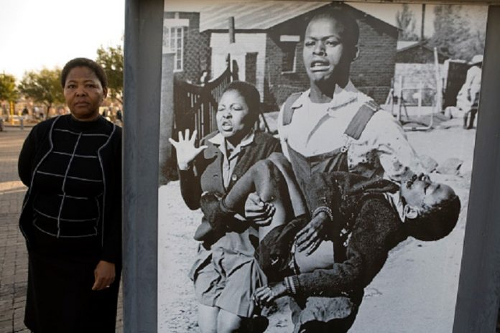News & Events
Youth Day in South Africa: Six essential things you need to know

Antoinette Sithole, sister of Hector Peterson who was murdered by South African police thirty years ago, poses alongside the iconic image by Sam Nzima at the Hector Peterson Memorial in Soweto. This photograph has been called 'the beginning of the end of apartheid' as it helped to mobilise the world agains the injustices of apartheid. In the original image she is running alongside student activist Mbuyisa Makhubu, who was forced to go into exile as a result of the photograph. Nobody know precisely what happened to him. As an exile he received a scholarship to study in Nigeria, where he was last heard from in 1978. She now works as a guide at the Hector Peterson Museum - Image Credits: Gideon Mendel / Corbis via Getty Images
With Youth Day almost upon us in South Africa, we feel it’s important to revisit our history and understand why exactly we’re here to remember it.
If you’re an international visitor and this is all completely new to you, we’ll talk you through why it’s such a huge deal in this country. If you’re fully aware of it… Well, a bit of revision never hurt anyone, did it?
What is Youth Day?
It’s a national day of remembrance for all the brave students and young citizens who took part in the Soweto Uprising protests.
Scores of students from the Gauteng suburb went on a march to protest against the unequal standard of education for black and white children. Black kids were subject to “Bantu” education, a poor and uninformative curriculum across the board.
As the young protesters made their way through the town, their plan was to attend a rally at Orlando Stadium. Sadly, they never made it. Apartheid police opened fire on the demonstrators, which became the catalyst for violent protest.
Streets, properties and vehicles were set alight as three days of rioting ensued. Iconic photos from the day children were massacred are said to have started the downfall of the apartheid regime – it was one cruelty too far for the watching world, who subsequently tightened their sanctions against SA.
Why does it fall on 16 June?
It’s simply because the protests started on 16 June 1976.
How many people died during the Soweto Uprising?
A number of sources quote 176 as being the official death toll. The apartheid government initially stated that 23 people had died during the conflict, but these figures have been widely discredited.
When was it first celebrated?
“Celebrated” may not be the right word, but it was recognised as a significant date of remembrance right from 1976. Memorials for the dead eventually became a celebration of the contribution South Africa’s youth had in the democratic revolution.
Is Youth Day a public holiday in South Africa?
It is, and if it falls between Monday to Friday, a day off is usually given for workers. However, in 2018, Youth Day falls on Saturday. It’s still good news if you work Saturday’s and your boss is a legend, but otherwise, it’ll be celebrated on the weekend.
How does South Africa celebrate Youth Day?
As we’ve mentioned, it is a public holiday of contrasts. The sadness of 1976 will never be forgotten and the pain is still felt today. But it’s also an opportunity to celebrate the bright young minds of the future: They’ve lifted us up before, and they will do so again in the near future.
Publish date: 2018/06/15
